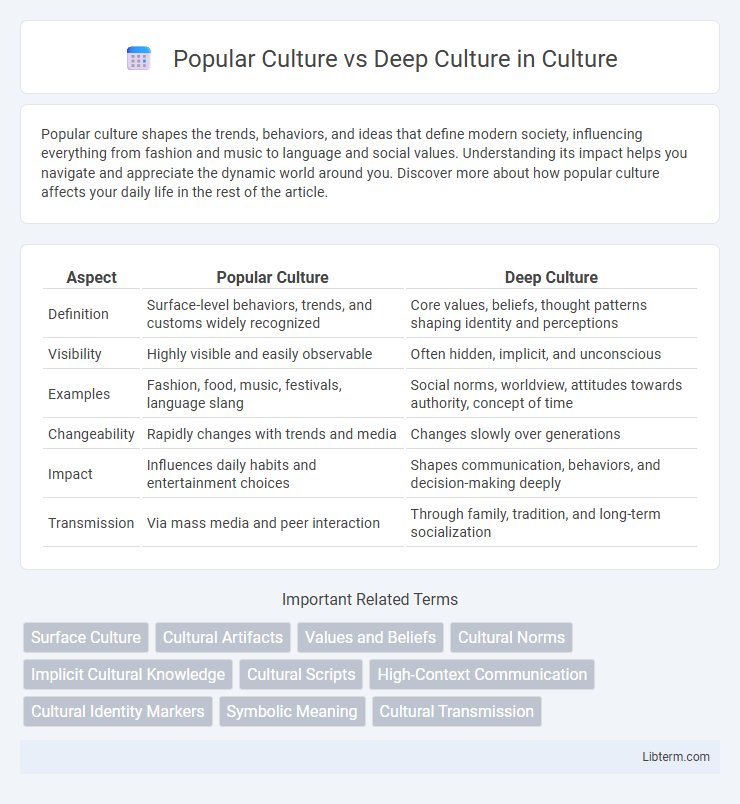Popular culture shapes the trends, behaviors, and ideas that define modern society, influencing everything from fashion and music to language and social values. Understanding its impact helps you navigate and appreciate the dynamic world around you. Discover more about how popular culture affects your daily life in the rest of the article.
Table of Comparison
| Aspect | Popular Culture | Deep Culture |
|---|---|---|
| Definition | Surface-level behaviors, trends, and customs widely recognized | Core values, beliefs, thought patterns shaping identity and perceptions |
| Visibility | Highly visible and easily observable | Often hidden, implicit, and unconscious |
| Examples | Fashion, food, music, festivals, language slang | Social norms, worldview, attitudes towards authority, concept of time |
| Changeability | Rapidly changes with trends and media | Changes slowly over generations |
| Impact | Influences daily habits and entertainment choices | Shapes communication, behaviors, and decision-making deeply |
| Transmission | Via mass media and peer interaction | Through family, tradition, and long-term socialization |
Defining Popular Culture and Deep Culture
Popular culture encompasses the widely recognized and accessible expressions of daily life such as music, fashion, and entertainment, which are easily observed and shared across social groups. Deep culture involves the underlying, often unconscious values, beliefs, customs, and norms that shape behavior and social interactions within a community, including attitudes toward family, work, and communication styles. Understanding the distinction between popular culture and deep culture is critical for comprehending both visible trends and the foundational social frameworks that govern cultural identity.
Origins and Evolution of Popular Culture
Popular culture originates from mass media, commercial entertainment, and widespread social trends reflecting contemporary society's shared experiences, values, and interests. It evolves rapidly through digital platforms, music, television, fashion, and social media, constantly adapting to consumer demand and technological advancements. Unlike deep culture, which stems from long-standing traditions and historical roots, popular culture is transient, dynamic, and driven by globalized communication networks.
The Foundations of Deep Culture
The foundations of deep culture consist of core values, belief systems, and worldviews that shape identity and social behavior within a community, often transmitted subconsciously through generations. Unlike popular culture, which includes visible and transient trends such as fashion, music, and entertainment, deep culture encompasses language use, rituals, customs, and non-verbal communication patterns that influence interpersonal relationships and decision-making. Understanding deep culture requires recognizing its embedded nature in social norms and ethical principles that persist over time, providing stability and continuity to cultural groups.
Key Contrasts Between Popular and Deep Culture
Popular culture encompasses superficial, visible elements such as fashion, music, and entertainment that are widely accessible and rapidly changing. Deep culture involves underlying values, beliefs, norms, and thought patterns that are ingrained, stable, and influence behavior unconsciously. The key contrasts lie in visibility, depth of impact, and durability, with popular culture being transient and surface-level, while deep culture shapes identity and societal cohesion over time.
Media’s Role in Shaping Popular Culture
Media plays a crucial role in shaping popular culture by disseminating trends, norms, and values through television, social media, and films, making cultural elements accessible and widely adopted. This widespread exposure often prioritizes surface-level traits such as fashion, language, and entertainment, which define popular culture, over the underlying beliefs, values, and traditions of deep culture. The media's influence accelerates cultural globalization while sometimes diluting deeper cultural identities that require more immersive engagement to understand fully.
Transmission and Preservation of Deep Culture
Deep culture encompasses the underlying values, beliefs, and norms that shape a community's identity and social interactions, often transmitted subtly through stories, rituals, and non-verbal communication within families and close-knit groups. Preservation of deep culture relies heavily on oral traditions, intergenerational teaching, and immersive experiences that foster a strong emotional connection and internalization of cultural essence beyond visible symbols. Unlike popular culture, which spreads rapidly through mass media and technology, deep culture requires active participation and continuous reinforcement within cultural contexts to endure over time.
Everyday Examples of Popular Culture
Popular culture manifests in everyday examples such as trending fashion styles, viral social media challenges, and widely consumed music genres like pop and hip-hop. These elements reflect shared tastes and common experiences accessible to a broad audience, contrasting deeply ingrained values, beliefs, and traditions found in deep culture. Popular culture's presence in mainstream media, fast food chains, and blockbuster movies highlights its role in shaping collective identity and social interaction.
Hidden Influences of Deep Culture in Daily Life
Deep culture shapes daily behaviors and values through ingrained norms, communication styles, and belief systems that remain unnoticed yet profoundly influence decisions and social interactions. Unlike popular culture's visible trends, deep culture governs core attitudes toward family, work, and community, guiding expectations and emotional responses at a subconscious level. Awareness of deep culture's hidden influence enhances cross-cultural understanding and improves interpersonal dynamics in multicultural environments.
Challenges in Understanding Deep Culture
Deep culture encompasses unspoken beliefs, values, and social norms that shape behavior beyond visible customs found in popular culture. Challenges in understanding deep culture arise from its implicit nature, making it difficult for outsiders to recognize and interpret without immersive experience and contextual knowledge. Misinterpretations and cultural biases frequently hinder accurate comprehension, leading to communication barriers and social misunderstandings.
The Interplay and Impact of Both Cultures on Society
Popular culture shapes everyday behaviors and social norms through widely accessible media, fashion, and entertainment, influencing collective identity and trends. Deep culture encompasses fundamental beliefs, values, and worldviews passed through generations, structuring societal values and interpersonal relationships at a subconscious level. The interplay between popular and deep culture drives societal evolution by balancing immediate cultural expression with enduring foundational principles, impacting social cohesion, innovation, and conflict resolution.
Popular Culture Infographic

 libterm.com
libterm.com